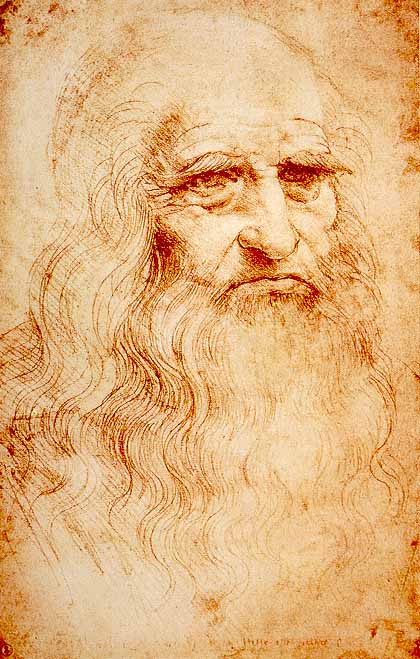
A new technique could help save a famous Leonardo da Vinci drawing that is vanishing with each passing day.
The mysterious da Vinci portrait, widely considered to be a self-portrait of the artist, was drawn with red chalk on paper in the early 1500s and has since been fading.
The new analysis could be used to help preservationists assess the damage to the painting and, in turn, help them decide which restoration techniques are most appropriate. [Anatomy Meets Art: See Da Vinci's Drawings]
Aging masterpiece
The enigmatic red-chalk-and-paper drawing has fueled speculation for centuries. The depiction of an old man with flowing white locks and a long beard was likely first completed in Turin, Italy, sometime between 1510 and 1515. While many think the painting depicts da Vinci, the Renaissance man was only in his mid-50s at the time of the drawing, whereas the portrait's subject looks closer to 80 years old. That has led many experts to wonder whether the drawing is of da Vinci's uncle or father.
The chalk portrait was drawn on paper composed of linen and cotton fibers and hemp rags, the researchers said. Once complete, the portrait's history was a mystery, until it was acquired by a Sardinian king in 1839 for the Royal Library of Turin. For decades in the 20th century, it was framed and displayed publicly, where it was exposed to sunlight, study co-author Mauro Missori, a researcher at the National Research Council in Italy, told Live Science in an email.
Centuries of poor conditions have led to the characteristic yellowing that is so common in ancient works of art. The yellowing reduces contrast with the red-chalk of the painting, making the image seem to vanish over time.
Get the world’s most fascinating discoveries delivered straight to your inbox.
As a result, the portrait was too fragile for general viewing, and since 1998 has been locked away in a temperature- and humidity-controlled vault at the Royal Library of Turin.
New technique
In 2012, the authors got a rare chance to inspect the masterpiece. The researchers quantified the level of chromophores, or light-absorbing compounds, in the cellulose that forms the paper. Chromophores preferentially absorb blue and violet light, and tend to scatter, or reflect, reddish and yellow-hued light, which gives old documents a yellowish tint.
So the team measured how much light was reflected and absorbed from the ancient painting at different wavelengths of light, which correspond to different colors. They then compared those values with ones from modern and ancient pieces of paper aged in various conditions.
The team found that the extreme yellowing likely resulted from the portrait's storage in a moist environment — perhaps a closed, dank space. As a follow-up, they'd like to do a second analysis to see whether the painting is continuing to degrade, or whether its fading has stabilized now that it is kept in better conditions, Missori said.
By quantifying the level of damage, the new study can help preservationists map out the best road to save this disappearing masterpiece. It could also help scientists assess damage to and preserve other ancient documents.
For now, the fate of the mysterious portrait is up in the air.
"A lively debate among scientists, conservators and restorers is taking place about the opportunity of performing a restoration intervention on Leonardo da Vinci's self-portrait," Missori said. Some want to avoid further damage by treating the portrait with chemicals or water-based solutions to remove chromophores and other byproducts of aging. But others are afraid that current methods for restoring ancient works of art are still too unproven, and would prefer to wait until preservation techniques improve, he said.
The new technique was detailed online today (June 3) in the journal Applied Physics Letters.
Follow Tia Ghose on Twitter and Google+. Follow Live Science @livescience, Facebook & Google+. Original article on Live Science.

Tia is the editor-in-chief (premium) and was formerly managing editor and senior writer for Live Science. Her work has appeared in Scientific American, Wired.com, Science News and other outlets. She holds a master's degree in bioengineering from the University of Washington, a graduate certificate in science writing from UC Santa Cruz and a bachelor's degree in mechanical engineering from the University of Texas at Austin. Tia was part of a team at the Milwaukee Journal Sentinel that published the Empty Cradles series on preterm births, which won multiple awards, including the 2012 Casey Medal for Meritorious Journalism.
